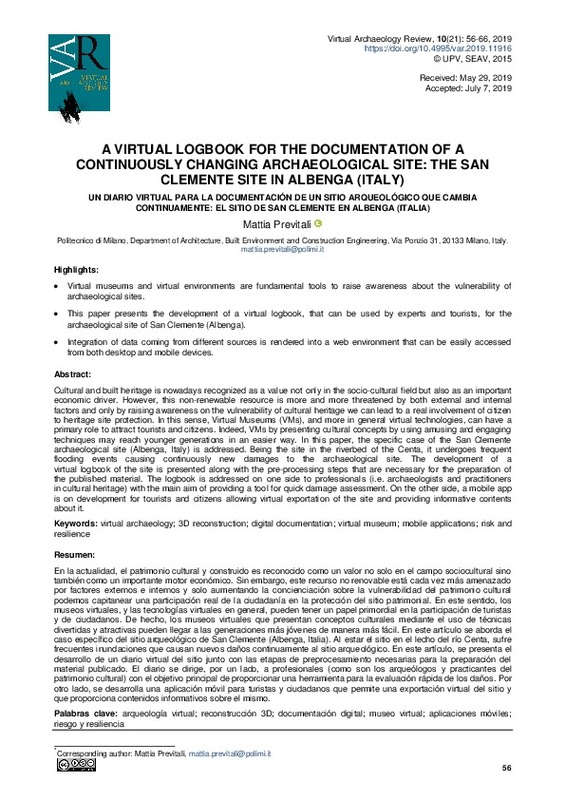JavaScript is disabled for your browser. Some features of this site may not work without it.
Buscar en RiuNet
Listar
Mi cuenta
Estadísticas
Ayuda RiuNet
Admin. UPV
A virtual logbook for the documentation of a continuously changing archaeological site: the San Clemente site in Albenga (Italy)
Mostrar el registro sencillo del ítem
Ficheros en el ítem
| dc.contributor.author | Previtali, Mattia
|
es_ES |
| dc.coverage.spatial | east=8.213007800000014; north=44.04687029999999; name=Strada Vicinale Del Molino, 5, 17031 Albenga SV, Itàlia | es_ES |
| dc.date.accessioned | 2019-09-02T10:03:12Z | |
| dc.date.available | 2019-09-02T10:03:12Z | |
| dc.date.issued | 2019-07-25 | |
| dc.identifier.uri | http://hdl.handle.net/10251/124729 | |
| dc.description.abstract | [EN] Cultural and built heritage is nowadays recognized as a value not only in the socio-cultural field but also as an important economic driver. However, this non-renewable resource is more and more threatened by both external and internal factors and only by raising awareness on the vulnerability of cultural heritage we can lead to a real involvement of citizen to heritage site protection. In this sense, Virtual Museums (VMs), and more in general virtual technologies, can have a primary role to attract tourists and citizens. Indeed, VMs by presenting cultural concepts by using amusing and engaging techniques may reach younger generations in an easier way. In this paper, the specific case of the San Clemente archaeological site (Albenga, Italy) is addressed. Being the site in the riverbed of the Centa, it undergoes frequent flooding events causing continuously new damages to the archaeological site. The development of a virtual logbook of the site is presented along with the pre-processing steps that are necessary for the preparation of the published material. The logbook is addressed on one side to professionals (i.e. archaeologists and practitioners in cultural heritage) with the main aim of providing a tool for quick damage assessment. On the other side, a mobile app is on development for tourists and citizens allowing virtual exportation of the site and providing informative contents about it.Highlights:Virtual museums and virtual environments are fundamental tools to raise awareness about the vulnerability of archaeological sites.This paper presents the development of a virtual logbook, that can be used by experts and tourists, for the archaeological site of San Clemente (Albenga).Integration of data coming from different sources is rendered into a web environment that can be easily accessed from both desktop and mobile devices. | es_ES |
| dc.description.abstract | [ES] En la actualidad, el patrimonio cultural y construido es reconocido como un valor no solo en el campo sociocultural sino también como un importante motor económico. Sin embargo, este recurso no renovable está cada vez más amenazado por factores externos e internos y solo aumentando la concienciación sobre la vulnerabilidad del patrimonio cultural podemos capitanear una participación real de la ciudadanía en la protección del sitio patrimonial. En este sentido, los museos virtuales, y las tecnologías virtuales en general, pueden tener un papel primordial en la participación de turistas y de ciudadanos. De hecho, los museos virtuales que presentan conceptos culturales mediante el uso de técnicas divertidas y atractivas pueden llegar a las generaciones más jóvenes de manera más fácil. En este artículo se aborda el caso específico del sitio arqueológico de San Clemente (Albenga, Italia). Al estar el sitio en el lecho del río Centa, sufre frecuentes inundaciones que causan nuevos daños continuamente al sitio arqueológico. En este artículo, se presenta el desarrollo de un diario virtual del sitio junto con las etapas de preprocesamiento necesarias para la preparación del material publicado. El diario se dirige, por un lado, a profesionales (como son los arqueólogos y practicantes del patrimonio cultural) con el objetivo principal de proporcionar una herramienta para la evaluación rápida de los daños. Por otro lado, se desarrolla una aplicación móvil para turistas y ciudadanos que permite una exportación virtual del sitio y que proporciona contenidos informativos sobre el mismo. | es_ES |
| dc.description.sponsorship | DABC, Gicarus Lab, Politecnico di Milano and Prof. Raffaella Brumana for their support and funding of this research. | es_ES |
| dc.language | Inglés | es_ES |
| dc.publisher | Universitat Politècnica de València | |
| dc.relation.ispartof | Virtual Archaeology Review | |
| dc.rights | Reconocimiento - No comercial - Sin obra derivada (by-nc-nd) | es_ES |
| dc.subject | Arqueología virtual | es_ES |
| dc.subject | Reconstrucción 3D | es_ES |
| dc.subject | Documentación digital | es_ES |
| dc.subject | Museo virtual | es_ES |
| dc.subject | Aplicaciones móviles | es_ES |
| dc.subject | Riesgo y resiliencia | es_ES |
| dc.subject | Virtual archaeology | es_ES |
| dc.subject | 3D reconstruction | es_ES |
| dc.subject | Virtual Museum | es_ES |
| dc.subject | Risk and resilience | es_ES |
| dc.subject | Digital documentation | es_ES |
| dc.subject | Mobile applications | es_ES |
| dc.title | A virtual logbook for the documentation of a continuously changing archaeological site: the San Clemente site in Albenga (Italy) | es_ES |
| dc.title.alternative | Un diario virtual para la documentación de un sitio arqueológico que cambia continuamente: el sitio de San Clemente en Albenga (Italia) | es_ES |
| dc.type | Artículo | es_ES |
| dc.date.updated | 2019-07-26T08:16:40Z | |
| dc.identifier.doi | 10.4995/var.2019.11916 | |
| dc.rights.accessRights | Abierto | es_ES |
| dc.description.bibliographicCitation | Previtali, M. (2019). A virtual logbook for the documentation of a continuously changing archaeological site: the San Clemente site in Albenga (Italy). Virtual Archaeology Review. 10(21):56-66. https://doi.org/10.4995/var.2019.11916 | es_ES |
| dc.description.accrualMethod | SWORD | es_ES |
| dc.relation.publisherversion | https://doi.org/10.4995/var.2019.11916 | es_ES |
| dc.description.upvformatpinicio | 56 | es_ES |
| dc.description.upvformatpfin | 66 | es_ES |
| dc.type.version | info:eu-repo/semantics/publishedVersion | es_ES |
| dc.description.volume | 10 | |
| dc.description.issue | 21 | |
| dc.identifier.eissn | 1989-9947 | |
| dc.contributor.funder | Politecnico di Milano | |
| dc.description.references | Barbieri, L., Bruno, F., & Muzzupappa, M. (2017). Virtual museum system evaluation through user studies. Journal of Cultural Heritage, 26, 101-108. https://doi.org/10.1016/j.culher.2017.02.005 | es_ES |
| dc.description.references | Brumana, R., Oreni, D., Caspani, S., & Previtali, M. (2018). Virtual museums and built environment: narratives and immersive experience via multi-temporal geodata hub. Virtual Archaeology Review, 9(19), 34-49. https://doi.org/10.4995/var.2018.9918 | es_ES |
| dc.description.references | Cots, I., Vilà, J., Diloli, J., Ferré, R., & Bricio, L. (2018). La arqueología virtual: de la excavación arqueológica a la gestión y socialización del patrimonio. Les cases de la Catedral (Tortosa) y el yacimiento protohistórico de La Cella(Salou), Tarragona. Virtual Archaeology Review, 9(19), 102-113. https://doi.org/10.4995/var.2018.9754 | es_ES |
| dc.description.references | Demetrescu, E., Ferdani, D., Dell'Unto, N., Touati, A. M. L., & Lindgren, S. (2016). Reconstructing the original splendour of the House of Caecilius Iucundus. A complete methodology for virtual archaeology aimed at digital exhibition. SCIRES-IT: SCIentific RESearch and Information Technology, 6(1), 51-66. http://doi.org/10.2423/i22394303v6n1p51 | es_ES |
| dc.description.references | Economou, M., & Meintani, E., (2011). Promising beginnings? Evaluating museum mobile phone apps. In Proceedings of the Re-Thinking Technology in Museums: Emerging Experience Conference, (pp. 87-101). University of Limerick, Ireland. | es_ES |
| dc.description.references | El Haje, N., Jessel, J. P., Gaildrat, V., & Sanza, C. (2016). 3D cities rendering and visualisation: a web-based solution. In Eurographics Workshop on Urban Data Modelling and Visualisation (UDMV 2016), (pp. 95-100). Liege, Belgium. http://doi.org/10.2312/udmv.20161426 | es_ES |
| dc.description.references | Galatis, P., Gavalas, D., Kasapakis, V., Pantziou, G. E., & Zaroliagis, C. D. (2016). Mobile augmented reality guides in cultural heritage. In Proceedings of the 8th EAI International Conference on Mobile Computing, Applications and Services, (pp. 11-19). ACM. https://doi.org/10.4108/eai.30-11-2016.2266954 | es_ES |
| dc.description.references | Hazan, S., Hermon, S., Turra, R., Pedrazzi, G., Franchi, M., & Wallergard, M., (2014). Theory design and current practice - Update on D3.1 (V_MUST.net-D3.1b). Retrieved on June 29, 2019, from http://www.v-must.net/sites/default/files/D3.1_update.pdf | es_ES |
| dc.description.references | Kersten, T. P., & Lindstaedt, M. (2012). Virtual architectural 3D model of the imperial cathedral (Kaiserdom) of Königslutter, Germany through terrestrial laser scanning. Lecture Notes in Computer Science, 7616, 201-210. https://doi.org/10.1007/978-3-642-34234-9_20 | es_ES |
| dc.description.references | Kersten, T. P., Tschirschwitz, F., & Deggim, S. (2017). Development of a virtual museum including a 4D presentation of building history in virtual reality. International Archives of the Photogrammetry, Remote Sensing and Spatial Information Sciences, XLII-2/W3, 361-367. https://doi.org/10.5194/isprs-archives-xlii-2-w3-361-2017. | es_ES |
| dc.description.references | Ioannides, M., & Davies, R. (2018). ViMM-Virtual Multimodal Museum: a manifesto and roadmap for Europe's digital cultural heritage. In International Conference on Intelligent Systems (IS), (pp. 343-350). Madeira, Portugal: IEEE. https://doi.org/10.1109/is.2018.8710556 | es_ES |
| dc.description.references | Ivarsson, E. (2009). Definition and prospects of the Virtual museum. (Master Thesis, Uppsala University). http://elinivarsson.com/docs/virtual_museums.pdf. | es_ES |
| dc.description.references | Massabò, B. (2002). Prime considerazioni sulle terme pubbliche di Albingaunum. Rivista di Archeologia, XXVI, 139-145. | es_ES |
| dc.description.references | Massabò, B. (2006). Albenga (Sv)-L'area archeologica nell'alveo del Centa: le terme pubbliche romane e la chiesa di San Clemente. FOLD&R FastiOnLine documents & research, (70), 1-13. | es_ES |
| dc.description.references | Perry, S., Roussou, M., Economou, M., Young, H., & Pujol, L. (2017). Moving beyond the virtual museum: Engaging visitors emotionally. In 23rd International Conference on Virtual System & Multimedia (VSMM), (pp. 1-8). Dublin, Ireland: IEEE. https://doi.org/10.1109/vsmm.2017.8346276 | es_ES |
| dc.description.references | Pescarin, S., Pagano, A., Wallergård, M., Hupperetz, W., Ray, C., Verhagen, P., & Earl, G. (2012). Evaluating Virtual Museums: Archeovirtual Case Study. Archaeology in the Digital Era (pp. 74-82). Amsterdam University Press. https://doi.org/10.1515/9789048519590-009 | es_ES |
| dc.description.references | Petridis, P., White, M., Mourkousis, N., Liarokapis, F., Sifniotis, M., Basu, A. & Gatzidis, C. (2007). Exploring and interacting with virtual museums. In Proceedings of the 33rd Annual Conference of Computer Applications and Quantitative Methods in Archaeology (CAA2005), (pp. 73-82). Tomar, Portugal. | es_ES |
| dc.description.references | Pivec, M., & Kronberger, A. (2016). Virtual museum: Playful visitor experience in the real and virtual world. In 8th International Conference on Games and Virtual Worlds for Serious Applications (VS-Games), (pp. 1-4). Barcelona: IEEE. https://doi.org/10.1109/vs-games.2016.7590376 | es_ES |
| dc.description.references | Previtali, M., Stanga, C., Molnar, T., Van Meerbeek, L., & Barazzetti, L. (2018). An integrated approach for threat assessment and damage identification on built heritage in climate-sensitive territories: the Albenga case study (San Clemente church). Applied Geomatics, 10(4), 485-499. https://doi.org/10.1007/s12518-018-0217-3 | es_ES |
| dc.description.references | Pujol, L. & Lorente, A., (2013). The virtual museum: a quest for the standard definition. Archaeology in the Digital Era. In Proceedings of the 40th Annual Conference of Computer Applications and Quantitative Methods in Archaeology (CAA), 40-48. | es_ES |
| dc.description.references | Roussou, M., & Katifori, A. (2018). Flow, staging, wayfinding, personalization: Evaluating user experience with mobile museum narratives. Multimodal Technologies and Interaction, 2(2), 32. https://doi.org/10.3390/mti2020032 | es_ES |
| dc.description.references | Scianna, A., La Guardia, M., & Scaduto, M. L. (2016). Sharing on web 3D models of ancient theatres. A methodological workflow. International Archives of the Photogrammetry, Remote Sensing and Spatial Information Sciences, XLI-B2, 483-490. https://doi.org/10.5194/isprs-archives-xli-b2-483-2016 | es_ES |
| dc.description.references | Sherman, W. R., & Craig, A. B. (2018). Understanding Virtual Reality: Interface, Application, and Design. San Francisco: Morgan Kaufmann. | es_ES |
| dc.description.references | Styliani, S., Fotis, L., Kostas, K. & Petros, P. (2009). Virtual museums, a survey and some issues for consideration. Journal of Cultural Heritage, 10(4), 520-528. https://doi.org/10.1016/j.culher.2009.03.003 | es_ES |
| dc.description.references | Tsichritzis, D., & Gibbs, S. (1991). Virtual Museums and Virtual Realities. In Proceedings of the International Conference on Hypermedia and Interactivity in Museums (pp. 14-16). Pittsburgh, PA. | es_ES |
| dc.description.references | Vayanou, M., Karvounis, M., Katifori, A., Kyriakidi, M., Roussou, M., & Ioannidis, Y. E. (2014). The CHESS Project: Adaptive personalized storytelling experiences in museums. In UMAP Project Synergy Workshop. Retrieved on May 24, 2019, from https://umappros.wordpress.com/ | es_ES |
| dc.description.references | Vergo, P. (1997). New Museology. London: Reaktion books. | es_ES |










